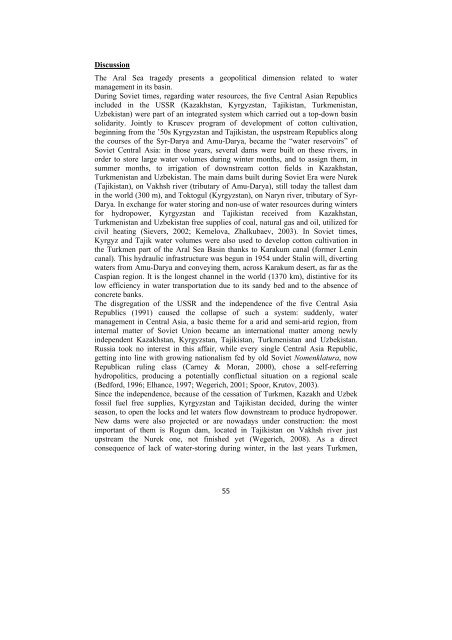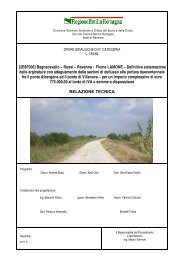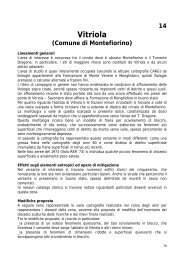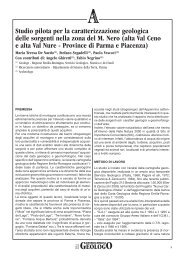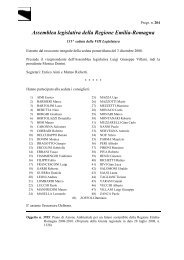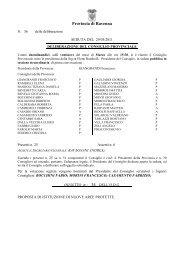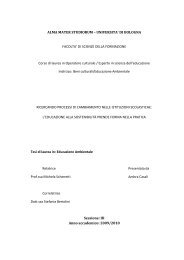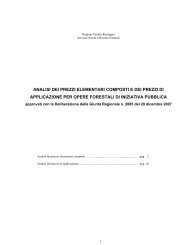air, water and soil quality qualité - ER Ambiente - Regione Emilia ...
air, water and soil quality qualité - ER Ambiente - Regione Emilia ...
air, water and soil quality qualité - ER Ambiente - Regione Emilia ...
You also want an ePaper? Increase the reach of your titles
YUMPU automatically turns print PDFs into web optimized ePapers that Google loves.
Discussion<br />
The Aral Sea tragedy presents a geopolitical dimension related to <strong>water</strong><br />
management in its basin.<br />
During Soviet times, regarding <strong>water</strong> resources, the five Central Asian Republics<br />
included in the USSR (Kazakhstan, Kyrgyzstan, Tajikistan, Turkmenistan,<br />
Uzbekistan) were part of an integrated system which carried out a top-down basin<br />
solidarity. Jointly to Kruscev program of development of cotton cultivation,<br />
beginning from the ’50s Kyrgyzstan <strong>and</strong> Tajikistan, the uspstream Republics along<br />
the courses of the Syr-Darya <strong>and</strong> Amu-Darya, became the “<strong>water</strong> reservoirs” of<br />
Soviet Central Asia: in those years, several dams were built on these rivers, in<br />
order to store large <strong>water</strong> volumes during winter months, <strong>and</strong> to assign them, in<br />
summer months, to irrigation of downstream cotton fields in Kazakhstan,<br />
Turkmenistan <strong>and</strong> Uzbekistan. The main dams built during Soviet Era were Nurek<br />
(Tajikistan), on Vakhsh river (tributary of Amu-Darya), still today the tallest dam<br />
in the world (300 m), <strong>and</strong> Toktogul (Kyrgyzstan), on Naryn river, tributary of Syr-<br />
Darya. In exchange for <strong>water</strong> storing <strong>and</strong> non-use of <strong>water</strong> resources during winters<br />
for hydropower, Kyrgyzstan <strong>and</strong> Tajikistan received from Kazakhstan,<br />
Turkmenistan <strong>and</strong> Uzbekistan free supplies of coal, natural gas <strong>and</strong> oil, utilized for<br />
civil heating (Sievers, 2002; Kemelova, Zhalkubaev, 2003). In Soviet times,<br />
Kyrgyz <strong>and</strong> Tajik <strong>water</strong> volumes were also used to develop cotton cultivation in<br />
the Turkmen part of the Aral Sea Basin thanks to Karakum canal (former Lenin<br />
canal). This hydraulic infrastructure was begun in 1954 under Stalin will, diverting<br />
<strong>water</strong>s from Amu-Darya <strong>and</strong> conveying them, across Karakum desert, as far as the<br />
Caspian region. It is the longest channel in the world (1370 km), distintive for its<br />
low efficiency in <strong>water</strong> transportation due to its s<strong>and</strong>y bed <strong>and</strong> to the absence of<br />
concrete banks.<br />
The disgregation of the USSR <strong>and</strong> the independence of the five Central Asia<br />
Republics (1991) caused the collapse of such a system: suddenly, <strong>water</strong><br />
management in Central Asia, a basic theme for a arid <strong>and</strong> semi-arid region, from<br />
internal matter of Soviet Union became an international matter among newly<br />
independent Kazakhstan, Kyrgyzstan, Tajikistan, Turkmenistan <strong>and</strong> Uzbekistan.<br />
Russia took no interest in this aff<strong>air</strong>, while every single Central Asia Republic,<br />
getting into line with growing nationalism fed by old Soviet Nomenklatura, now<br />
Republican ruling class (Carney & Moran, 2000), chose a self-referring<br />
hydropolitics, producing a potentially conflictual situation on a regional scale<br />
(Bedford, 1996; Elhance, 1997; Wegerich, 2001; Spoor, Krutov, 2003).<br />
Since the independence, because of the cessation of Turkmen, Kazakh <strong>and</strong> Uzbek<br />
fossil fuel free supplies, Kyrgyzstan <strong>and</strong> Tajikistan decided, during the winter<br />
season, to open the locks <strong>and</strong> let <strong>water</strong>s flow downstream to produce hydropower.<br />
New dams were also projected or are nowadays under construction: the most<br />
important of them is Rogun dam, located in Tajikistan on Vakhsh river just<br />
upstream the Nurek one, not finished yet (Wegerich, 2008). As a direct<br />
consequence of lack of <strong>water</strong>-storing during winter, in the last years Turkmen,<br />
<br />
55


